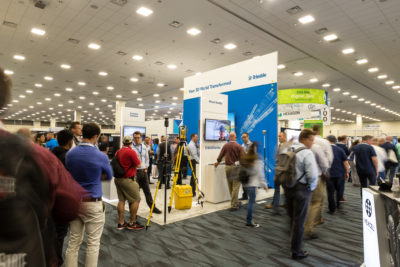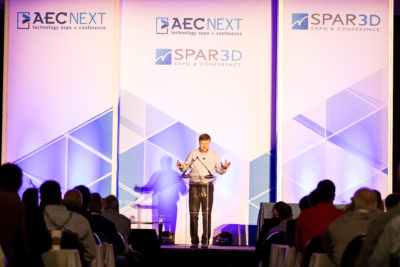Perusing the news on one’s phone every morning can be a dispiriting experience, as so many of the constants that have safeguarded those of us in many countries of the world for decades, such as environmental, democratic and security constructs, have become stochastic. I have been lucky to enjoy a life sheltered from many of Hamlet’s “slings and arrows of outrageous fortune”, but the California wildfires and, very recently, the tragedy at the Chabad of Poway, less than a kilometer from my home, bring them uncomfortably to life.
The above reflection implies that perhaps we insufficiently appreciate good kismet. Talking to another geospatial professional last week, however, I marveled at my luck. While in principle “retired”, I have the privilege of reading, writing, traveling and participating in multiple ways in the geospatial profession and community. In March I attended the Esri Partner Conference in Palm Springs—a beautiful setting in the cooler months—and saw how the host company, founded 50 years ago, and the remarkable community of users and partners that it leads, develop geospatial thinking and practice. Later in the month, I was invited to a meeting in Toronto of the Council of the International Society for Photogrammetry and Remote Sensing (ISPRS), comprised of six eminent geospatial academics wrestling with the guidance of global research and international cooperation in photogrammetry, remote sensing and their applications. The milestones leading to the XXIVth ISPRS Congress in Nice, France, in June 2020 are upon us—it will be a conference not to miss, an opportunity to learn about the critical trends in lidar. My role in Toronto was to represent The ISPRS Foundation, which is ISPRS’s charitable arm supporting ISPRS activities in many ways, the most rewarding of which is travel grants to students from developing countries to enable them to attend ISPRS events and present their papers.
On the same trip I was able to visit two leading players in our lidar world. Applanix and Teledyne Optech. Articles are in preparation, which I hope will transmit the competence of these long-term stakeholders, blended with their palpable excitement at new developments in both the technology and the market.
The SPAR 3D/AEC Next event in Anaheim, California in May was part of the Diversified Communications portfolio and once again the firm acquitted itself very competently. There were 1900 attendees, a significant increase over 2018, from 33 countries, all 50 states and the District of Columbia, and seven Canadian provinces.

A view of the bustling exhibition hall at SPAR 3D/AEC Next in Anaheim, 21-23 May 2019. Photo courtesy of Diversified Communications.
The bustling trade show accommodated 118 exhibiting companies. The conference encompassed more than 80 sessions and five keynote presentations. More than 60% of the attendees were first-timers. This was the second instance of the joint event and, after two successful years in Anaheim, Diversified Communications is moving it to Chicago—mark your calendars for 3-5 June 2020. One of the frustrations of my role at such events is that I cannot cover every session and exhibitor. But, at risk of being too eclectic, I will give my enthusiasm full rein. After the product previews on the Tuesday morning, I moderated a session on “AEC project case studies”. It was superb! Five incredibly highly qualified speakers who were well prepared, eloquent and kept to time, described the provision by Firmatek of UAV-lidar services for Turner Mining Group; . the use by Corgan of augmented reality on projects at LAX; Borton-Lawson’s generation of business benefits for the nuclear industry of 3D reality capture. All the talks were superbly illustrated, to the extent that the nuclear one jump-started memories of K-19: The Widowmaker! I’ve already pressganged some of the authors for articles.
On the Wednesday I relished one of the most fulfilling mornings I have experienced at a conference for many years. MiMi Aung from NASA described the Mars Helicopter project with enthusiasm and animation that had the audience spellbound. She outlined the challenges of delivering a UAV rotorcraft to Mars then flying it autonomously in the Martian atmosphere—and how NASA has risen to each one. Twelve hours later, I encountered her again, in a social event, where she was similarly enrapturing Jon Snoddy of Walt Disney Imagineering, one of the Thursday keynotes. MiMi was followed on stage by Bob Sutor of IBM Research to tell us about quantum computing, where it is now and where it is going. He was brilliant too and by the end I was beginning to understand it. After catching up with Phoenix Lidar Systems during the break, I took in an AEC session on historic preservation—three more fabulous presentations. Speakers from Leica Geosystems, Johns Hopkins and structural engineers Silman described the scanning, modeling and analysis of, respectively: Frank Lloyd Wright’s Taliesin West near Phoenix, Arizona; Cologne cathedral—with very scary photos of scanning stations on the towers—and CERN’s Large Hadron Collider near Geneva, Switzerland; and the historically important but deteriorating concrete structure of Harvard Stadium. Next, we gentlepersons of the press were invited to a luncheon to hear Bentley VP Bob Mankowski address the topic, “Digital twin technology for digital cities”, a well illustrated talk on the applications of his firm’s latest product offerings. What a way to spend a morning!

Dr. Robert S (Bob) Sutor, Vice President, IBM Q Strategy and Ecosystem, IBM Research presenting “Quantum computing: a view to the future” during Wednesday’s keynote session at SPAR 3D/AEC Next. Photo courtesy of Diversified Communications.
It’s natural to rhapsodize about events where we network and hear the latest developments in our own fields. The collegial atmosphere of conferences is stimulating per se. Everything seems vibrant and inspiring. But is it real? Can we have a perspective? Glance at pages 6 and 7 of this issue. Global Marketing Insights has released a research report on the global lidar market and the statistics are remarkable. The firm estimates that the market will grow from $1b in 2019 to $10b in 2025, a compound annual growth rate (CAGR) of more than 35%. I’ve seen many of these research reports and they’re all limited by the sample of companies interviewed in the underlying survey; yet I’ve seen very few that predict growth of this magnitude. CAGRs are given by market segments: >25% for topographic lidar; >30%, bathymetric; >37%, UAV; >50%, driverless cars; >32%, environmental. The North American market will grow faster than the European one, and by 2025 UAV-lidar will generate almost as much revenue as airborne. There will be partnerships and mergers as firms jostle for places on the food chain. I think we’re in the right place at the right time and the excitement of my recent travels is a authentic reflection of the industry in which we’re fortunate to be participating.
Finally, wearing my ASPRS hat, I have become aware of ongoing work by its LIDAR Division. A new working group for Lidar Accuracy Research is focusing on the uncertainty guidelines and various related specifications. Another working group for Alternative Point Cloud File Format Research exploring efficient methods to handle point clouds. I will pursue these groups for an article on their activities!
Readers will tolerate—or dread—my penchant for reporting, in a whimsical way, items I read in The Economist from time to time that are in some way related to lidar. Importantly, in a briefing on Chinese mobility, the newspaper reported that, “RoboSense, a startup in which Alibaba, SAIC and BAIC [a Chinese carmaker] have all invested, is taking on Western firms developing the lidar sensors that tell autonomous vehicles about their surroundings.”1 We won’t even mention 5G! But there are other Chinese players in this market and we have an article ready to print about one of them. This will be another demonstration of the impetus provided to R&D by the AV market overflowing into the UAV-lidar world.
1 Anon, 2019a. Great wheels of China, The Economist, 431(9137): 19, 6 April.